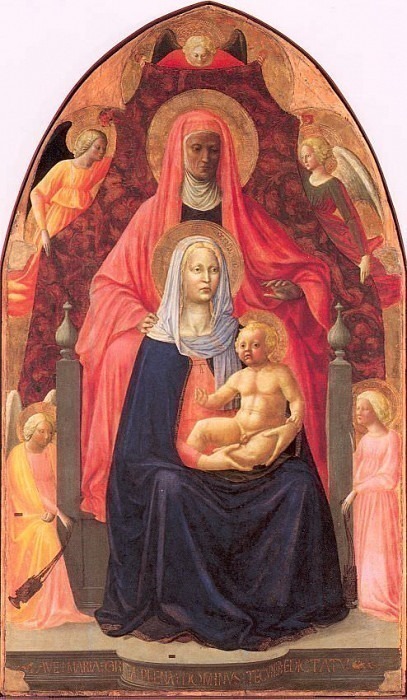Saint Anne with Madonna and Child Masolino da Panicale (Tommaso di Cristoforo Fini) (1383-1447)
Masolino da Panicale – Saint Anne with Madonna and Child
Edit attribution
Download full size: 494×850 px (0,1 Mb)
Painter: Masolino da Panicale (Tommaso di Cristoforo Fini)
"Saint Anne with Madonna and Child," commonly referred to as Sant’Anna Metterza, is a pictorial work in tempera paint, measuring 175x103 cm. It is attributed to the great Masaccio, who painted it between 1424 and 1425. It is in the Uffizi Gallery in Florence. The work is a masterpiece of Masaccio’s work and one of the key paintings of the first milestones of the Florentine Renaissance. It is thought that it was painted by Masaccio for the basilica of the Florentine church of Sant’Ambrogio, then in 1813 it became part of the collection of the Accademia delle Arti, and finally of the Uffizi Gallery in 1919. The form of the work is unusual for the time, with no side panels, some researchers have suggested that it was the central panel of a polyptych that was divided in 1568. Three angels lay a precious damask drapery behind the Madonna, Child, and St.
Description of Masaccio’s "Saint Anne with the Madonna and Child"
"Saint Anne with Madonna and Child," commonly referred to as Sant’Anna Metterza, is a pictorial work in tempera paint, measuring 175x103 cm. It is attributed to the great Masaccio, who painted it between 1424 and 1425. It is in the Uffizi Gallery in Florence. The work is a masterpiece of Masaccio’s work and one of the key paintings of the first milestones of the Florentine Renaissance.
It is thought that it was painted by Masaccio for the basilica of the Florentine church of Sant’Ambrogio, then in 1813 it became part of the collection of the Accademia delle Arti, and finally of the Uffizi Gallery in 1919.
The form of the work is unusual for the time, with no side panels, some researchers have suggested that it was the central panel of a polyptych that was divided in 1568.
Three angels lay a precious damask drapery behind the Madonna, Child, and St. Anne, creating the depth of the painting, a background much more modern than the all-gold specified in the Renaissance canons. At the bottom of the painting are two more angels, whose figures also follow hierarchical proportions-they are much smaller than the figures of the saints. The saints, in turn, are seated on a two-part throne with a pedestal.
Art historians agree that the iconographic canons suggested that the figure of St. Anne, mother of Mary and grandmother of Christ, was supposed to reinforce the Madonna and Child. This is evidenced by the protective gesture, the hand positioned above the head of the Child. The original use of light, painted by Masaccio, inexorably moves the focus to the two figures in the foreground, which was contrary to traditional iconography.
Кому понравилось
Пожалуйста, подождите
На эту операцию может потребоваться несколько секунд.
Информация появится в новом окне,
если открытие новых окон не запрещено в настройках вашего браузера.
You need to login
Для работы с коллекциями – пожалуйста, войдите в аккаунт (open in new window).











![Masolino da Panicale (Tommaso di Cristoforo Fini) - Madonna and Child with St John the Baptist and St Francis [Attributed]](http://cdn.gallerix.asia/j/M/9685/37.webp)




You cannot comment Why?
Flanking this central grouping are two smaller female figures, seemingly attendants or angels, one holding a trumpet, the other standing passively. Their poses suggest reverence and participation in the unfolding scene. Behind these figures, within the overarching arch of the composition, further angelic presences are visible, their forms less distinct but contributing to an atmosphere of celestial grandeur.
The architectural setting is defined by slender columns that frame the central group, creating a sense of enclosure and emphasizing their importance. A band of Latin inscription runs along the lower edge of the painting, its meaning obscured but adding another layer of symbolic weight. The color palette is rich and saturated, with deep blues and reds contrasting against lighter tones in the figures’ skin and drapery.
The arrangement suggests a lineage or generational connection between the three female figures. The older womans position behind the younger one implies a role of support, guidance, or perhaps divine intercession. The infant held by the younger woman is clearly the focal point of devotion, his nudity emphasizing vulnerability and innocence. The inclusion of angels reinforces the sacred nature of this familial bond, elevating it to a realm beyond earthly experience.
The painting’s subtexts likely revolve around themes of motherhood, generational continuity, divine grace, and the sanctity of family relationships. The architectural setting and the presence of angelic figures suggest a connection between the human world and the divine, while the inscription hints at a deeper theological meaning that remains partially veiled to the viewer.